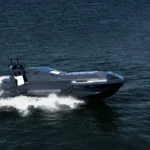The Royal Australian Navy (RAN) has officially accepted delivery of its ninth Evolved Cape Class Patrol Boat (ECCPB) from Austal Australia, marking a significant milestone in its ongoing fleet modernization and maritime security efforts. The latest vessel enhances the RAN’s ability to conduct border protection, fisheries patrols, and regional presence missions across Australia’s vast maritime domain.
Background of the Evolved Cape Class Program
The Evolved Cape Class Patrol Boat program was initiated to bridge capability gaps between the aging Armidale-class patrol boats and the delayed Arafura-class Offshore Patrol Vessels (OPVs). In May 2020, the Australian Government awarded Austal a contract worth AUD 324 million for six ECCPBs. This was later expanded to eight vessels in April 2022 with an additional AUD 124 million investment. The ninth vessel now delivered is part of a follow-on order reflecting continued confidence in the platform’s performance.
Designed and built by Austal at its Henderson shipyard in Western Australia, the ECCPBs are based on the original Cape Class design but incorporate over 30 enhancements aimed at improving crew habitability, operational availability, and mission endurance.
Key Features and Enhancements
The ECCPB is a 58-meter-long aluminum monohull patrol vessel optimized for long-range missions in Australia’s northern approaches. Key technical specifications include:
- Length: 58 meters
- Beam: 10.3 meters
- Crew capacity: Up to 32 personnel (standard complement of 22)
- Range: Over 4,000 nautical miles at 12 knots
- Endurance: Up to 28 days without resupply
The “Evolved” variant includes several improvements over the original Cape Class boats used by both RAN and Australian Border Force (ABF), such as:
- Improved crew accommodation standards to support mixed-gender crews
- Larger galley and improved mess facilities
- Upgraded communications suite compatible with future C4ISR integration
- Simplified maintenance architecture for higher availability rates
Operational Role within RAN Fleet Structure
The ECCPBs serve as multi-role platforms primarily tasked with constabulary duties including illegal fishing interdiction, counter-smuggling operations, migrant interception, and sovereignty patrols. They are also capable of supporting limited military operations such as surveillance support during joint exercises or humanitarian assistance missions.
The class fills an important capability gap while delays persist in the Arafura-class OPV program. Originally expected to enter service starting in late-2022, Arafura deliveries have been pushed back due to construction delays at Osborne Naval Shipyard. As a result, ECCPBs are extending their operational relevance well into the late-2020s.
Austal’s Role and Domestic Industrial Impact
Austal Australia has played a central role in sustaining domestic naval shipbuilding capacity through this program. The ECCPB project supports over 400 direct jobs at Austal’s Henderson facility and hundreds more across supply chains nationwide.
Austal has integrated lessons learned from previous builds into each successive hull—streamlining production timelines while enhancing quality assurance processes. According to company statements, all vessels have been delivered on time or ahead of schedule despite global supply chain disruptions caused by COVID-19.
Future Outlook for Patrol Capabilities
The continued investment in ECCPBs suggests that Australia may adopt a hybrid patrol fleet model even after full induction of Arafura-class OPVs. With increasing regional tensions—particularly around illegal fishing activities in northern waters—the need for persistent presence platforms remains high.
The ECCPB platform could also be considered as a candidate for export or regional security cooperation programs under Australia’s Defence Strategic Review framework. Moreover, modularity features may allow future retrofitting with unmanned systems or advanced ISR payloads depending on evolving mission requirements.








